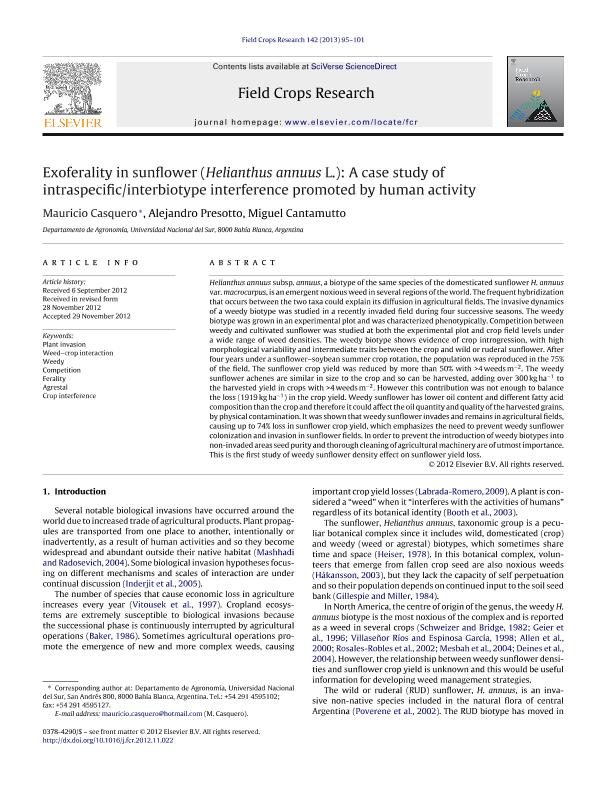Artículo
Exoferality in sunflower (Helianthus annuus L.): A case study of intraspecific/interbiotype interference promoted by human activity
Fecha de publicación:
05/2013
Editorial:
Elsevier Science
Revista:
Field Crops Research
ISSN:
0378-4290
Idioma:
Inglés
Tipo de recurso:
Artículo publicado
Clasificación temática:
Resumen
Helianthus annuus subsp. annuus, a biotype of the same species of the domesticated sunflower H. annuus var. macrocarpus, is an emergent noxious weed in several regions ofthe world. The frequent hybridization that occurs between the two taxa could explain its diffusion in agricultural fields. The invasive dynamics of a weedy biotype was studied in a recently invaded field during four successive seasons. The weedy biotype was grown in an experimental plot and was characterized phenotypically. Competition between weedy and cultivated sunflower was studied at both the experimental plot and crop field levels under a wide range of weed densities. The weedy biotype shows evidence of crop introgression, with high morphological variability and intermediate traits between the crop and wild or ruderal sunflower. After four years under a sunflower–soybean summer crop rotation, the population was reproduced in the 75% of the field. The sunflower crop yield was reduced by more than 50% with >4 weeds m−2. The weedy sunflower achenes are similar in size to the crop and so can be harvested, adding over 300 kg ha−1 to the harvested yield in crops with >4 weeds m−2. However this contribution was not enough to balance the loss (1919 kg ha−1) in the crop yield. Weedy sunflower has lower oil content and different fatty acid composition than the crop and therefore it could affectthe oil quantity and quality ofthe harvested grains, by physical contamination. It was shown that weedy sunflower invades and remains in agricultural fields, causing up to 74% loss in sunflower crop yield, which emphasizes the need to prevent weedy sunflower colonization and invasion in sunflower fields. In order to prevent the introduction of weedy biotypes into non-invaded areas seed purity and thorough cleaning of agricultural machinery are of utmost importance. This is the first study of weedy sunflower density effect on sunflower yield loss.
Archivos asociados
Licencia
Identificadores
Colecciones
Articulos(CCT - BAHIA BLANCA)
Articulos de CTRO.CIENTIFICO TECNOL.CONICET - BAHIA BLANCA
Articulos de CTRO.CIENTIFICO TECNOL.CONICET - BAHIA BLANCA
Citación
Casquero, Mauricio Javier; Presotto, Alejandro Daniel; Cantamutto, Miguel Ángel; Exoferality in sunflower (Helianthus annuus L.): A case study of intraspecific/interbiotype interference promoted by human activity; Elsevier Science; Field Crops Research; 142; 5-2013; 95-101
Compartir
Altmétricas




